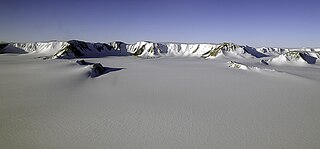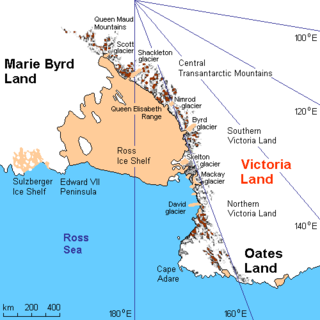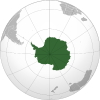The Marsh Glacier is a glacier about 110 km (70 mi) long, flowing north from the Antarctic polar plateau between the Miller Range and Queen Elizabeth Range into Nimrod Glacier. Seen by a New Zealand party of the CTAE (1956–58) and named for G.W. Marsh, a member of the party.

The Shackleton Range is a mountain range in Antarctica. Rising at Holmes Summit to 1,875 metres (6,152 ft), it extends in an east–west direction for about 160 kilometres (99 mi) between the Slessor and Recovery glaciers.
The Slessor Glacier is a glacier at least 140 km long and 90 km wide, flowing west into the Filchner Ice Shelf to the north of the Shackleton Range. First seen from the air and mapped by the Commonwealth Trans-Antarctic Expedition (CTAE) in 1956. Named by the CTAE for RAF Marshal Sir John Slessor, chairman of the expedition committee.

Skelton Glacier is a large glacier flowing from the polar plateau into the Ross Ice Shelf at Skelton Inlet on the Hillary Coast, south of Victoria Land, Antarctica.

The Theron Mountains are a group of mountains, extending in a NE-SW direction for 45 kilometres (28 mi) and rising 1,175 metres (3,855 ft), on the eastern side of the Filchner Ice Shelf. They were first seen from the air in 1956 by the Commonwealth Trans-Antarctic Expedition (CTAE) and named for the Theron, the ship of the CTAE in 1955–56.
The Cook Mountains is a group of mountains bounded by the Mulock and Darwin glaciers in Antarctica. Parts of the group were first viewed from the Ross Ice Shelf by the British National Antarctic Expedition (1901–04). Additional portions of these mountains were mapped by a New Zealand party of the CTAE (1956–58), and they were completely mapped by the USGS from Tellurometer surveys and US Navy air photos, 1959–63.
The Herbert Mountains are a conspicuous group of rock summits on the east side of Gordon Glacier in the Shackleton Range of Antarctica. They were first mapped in 1957 by the Commonwealth Trans-Antarctic Expedition (and named for Sir Edwin S. Herbert, Chairman of the Finance Committee and a Member of the Committee of Management of the expedition, 1955–58.
Mount Ellis is the highest mountain, 2,330 m, of the Darwin Mountains, surmounting the northern edge of Midnight Plateau. Mapped by the Darwin Glacier Party of the CTAE (1956–58). Named for M.R. Ellis, engineer with the CTAE, who accompanied Sir Edmund Hillary to the South Pole.
Gordon Glacier is an Antarctic glacier of at least 24 nautical miles in length flowing in a northerly direction beginning in the Crossover Pass, flowing through the Shackleton Range to finally meet the Slessor Glacier. The glacier was first mapped in 1957 by the CTAE, and named after George Patrick Pirie-Gordon, 15th Laird of Buthlaw, who was a member of the Committee of Management and treasurer of the CTAE between 1955 and 1958.
Blaiklock Glacier is a glacier 16 nautical miles (30 km) long, flowing north from Turnpike Bluff, then northwest to Mount Provender and Mount Lowe in the western part of the Shackleton Range, Antarctica. It was first mapped in 1957 by the Commonwealth Trans-Antarctic Expedition (CTAE), and named for Kenneth V. Blaiklock, the leader of the advance party of the CTAE in 1955–56 and a surveyor with the transpolar party in 1956–58.
Bowden Névé is a névé in Antarctica about 20 nautical miles (40 km) wide, lying southward of Mount Miller between the Queen Elizabeth Range and the Queen Alexandra Range. It was observed in 1958 by the New Zealand Southern Party of the Commonwealth Trans-Antarctic Expedition (CTAE) (1956–58) and named for Charles M. Bowden, Chairman of the Ross Sea Committee which organized the New Zealand party of the CTAE.

Coalseam Cliffs are rock cliffs forming the north-western part of Mount Faraway in the Theron Mountains. They were first mapped in 1956–57 by the Commonwealth Trans-Antarctic Expedition (CTAE), and so named because a coal seam was found when members of the CTAE made an aircraft landing there in 1957.
Cranfield Peak is a peak, 2,850 metres (9,350 ft) high, standing 6 nautical miles (11 km) south of Mount Weeks in the Queen Elizabeth Range. Tentatively named "Sentinel Peak" by the New Zealand Southern Survey Party of the Commonwealth Trans-Antarctic Expedition (CTAE) (1956–58), who visited it in 1958, it was renamed for Flying Officer W.J. Cranfield who, as one of the pilots operating with the CTAE, gave considerable assistance to the surveying party in this area.
Mount Greenfield is an ice-free mountain rising to 1,490 metres (4,890 ft) and surmounting the western extremity of Stephenson Bastion in the Shackleton Range of Antarctica. It was mapped in 1957 by the Commonwealth Trans-Antarctic Expedition (CTAE) and named after George C. Greenfield, a literary agent of the CTAE from 1955 to 1958.
Glen Glacier is a glacier at least 7 nautical miles (13 km) long, flowing south in the Shackleton Range of Antarctica to join Recovery Glacier to the west of the Read Mountains. It was first mapped in 1957 by the Commonwealth Trans-Antarctic Expedition (CTAE) and named for Alexander Richard "Sandy" Glen, a member of the Committee of Management of the CTAE, 1955–58.
Goldsmith Glacier is a glacier flowing west-northwest through the Theron Mountains of Antarctica, 6 nautical miles (11 km) south of Tailend Nunatak. It was first mapped in 1956–57 by the Commonwealth Trans-Antarctic Expedition (CTAE) and named for Rainer Goldsmith, medical officer with the advance party of the CTAE in 1955–56.
Stephenson Bastion is a mountain massif with steep rock cliffs on its south side, rising to 1,850 m in the south-central part of Shackleton Range. It was first mapped in 1957 by the Commonwealth Trans-Antarctic Expedition, and it was photographed by U.S. Navy aircraft in 1967. It was named by the United Kingdom Antarctic Place-Names Committee (UK-APC) for Philip J. Stephenson, an Australian geologist with the transpolar party of the CTAE in 1956–58.
Mount Skidmore is a mountain on the east side of the mouth of Stratton Glacier in the Shackleton Range. It was first mapped in 1957 by the CTAE, and it was photographed in 1967 by U.S. Navy trimetrogon aerial photography. It was named by the United Kingdom Antarctic Place-Names Committee (UK-APC) for Michael J. Skidmore, a British Antarctic Survey (BAS) geologist at the Brunt Ice Shelf between 1966 and 1969 who worked in the Shackleton Range from 1968 to 1969.
La Grange Nunataks is a scattered group of nunataks extending west for 22 nautical miles (41 km) from the mouth of Gordon Glacier, on the north side of the Shackleton Range, Antarctica. They were first mapped in 1957 by the Commonwealth Trans-Antarctic Expedition (CTAE), and were photographed in 1967 by U.S. Navy aircraft. They were named by the UK Antarctic Place-Names Committee for Johannes J. La Grange, a South African meteorologist with the CTAE.
Mount Macdonald is a peak rising to 3,630 metres (11,910 ft) surmounting the massive N-S trending ridge between Ludeman Glacier and Pain Neve in the Commonwealth Range. Named by New Zealand Geological Survey Antarctic Expedition (NZGSAE) (1961–62) for the Hon. T.L. Macdonald, who was Minister of External Affairs and of Defence when the Commonwealth Trans-Antarctic Expedition (CTAE) (1956–58) was being planned and who took a prominent part in obtaining New Zealand participation in the Antarctic.
![]() This article incorporates public domain material from "Mount Absalom". Geographic Names Information System . United States Geological Survey.
This article incorporates public domain material from "Mount Absalom". Geographic Names Information System . United States Geological Survey. 




